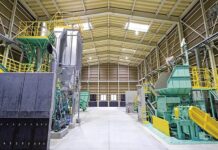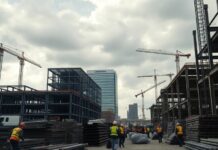In the vast and intricate world of construction projects, the cornerstone of financial and legal security often lies within the realms of title insurance.
This specialized form of insurance plays a pivotal role in safeguarding lenders against the potential loss of lien priority, a risk that looms large when navigating the complexities of construction loans and the disbursement of funds.
The essence of title insurance in construction projects transcends mere risk mitigation; it ensures the stability of financial investments by protecting against unforeseen claims and complications that can arise from mechanic’s liens.
These liens, rooted in unpaid labor, services, or materials, possess the unique ability to retroactively threaten the lien priority of lenders, casting a shadow of uncertainty over the financial backbone of construction endeavors.
The strategic incorporation of title insurance emerges as a beacon of assurance, offering a protective shield that preserves the hierarchy of financial interests amidst the dynamic landscape of construction financing.
Title Insurance Companies: The Backbone Of Construction Project Security
Navigating the complexities of title insurance in construction requires understanding the entities at its core: title insurance companies.
These institutions serve as the guardians of financial security, meticulously evaluating risks to ensure that lenders remain protected against claims that could jeopardize their lien priority.
This protection is paramount in the construction sector, where the fluidity of projects and the involvement of numerous contractors and materials suppliers can lead to a tangled web of potential claims.
Finding The Right Agency
Selecting the right commercial title agency is a crucial step for stakeholders in a construction project.
It’s not just about choosing a provider; it’s about finding a partner equipped with the expertise and resources to navigate the unique challenges of construction projects.
The right agency offers comprehensive coverage options tailored to construction-specific risks, including mechanic’s liens, which can disrupt the financial hierarchy of a project.
Stakeholders should seek agencies that not only provide robust policies but also possess a deep understanding of the construction industry’s landscape, ensuring that coverage is not just a formality but a strategic asset.
Enhancing Project Security Through Detailed Risk Assessment
Title insurance agencies contribute to project security by conducting thorough risk assessments.
This process involves examining the project’s details and potential title issues that could arise, ensuring that coverage is meticulously tailored to the project’s specific risks.
By identifying and mitigating these risks early on, title insurance agencies play an instrumental role in safeguarding the project’s financial stability.
Streamlining The Construction Loan Process
The interplay between construction loan funding and title insurance is intricate, requiring specialized knowledge and careful management to ensure that the lender’s lien priority is preserved throughout the project’s duration.
Title insurance for construction loans differs significantly from that of permanent loans, necessitating specific endorsements and continuous adjustments to the policy as the project progresses and funds are disbursed.
Effective management of this process, including the procurement of lien waivers and the strategic use of future advance clauses, is essential for maintaining the senior position of the mortgage and ensuring comprehensive coverage against mechanic’s liens and other title-related issues.
Navigating The Future Of Construction: A Global Perspective
The construction industry is undergoing significant transformations, driven by technological innovations, economic fluctuations, and evolving sustainability goals.
These changes are reshaping the landscape of construction globally, presenting both challenges and opportunities for firms willing to adapt and innovate.
Embracing Technological Advances
The construction sector is increasingly leveraging technological advancements to enhance efficiency, safety, and sustainability.
The adoption of generative AI, drones, autonomous vehicles, and IoT sensors is enabling construction firms to reduce costs, improve project delivery, and enhance building performance.
These technologies facilitate better monitoring, inspection, and material delivery at construction sites, offering a competitive edge to firms that integrate them into their operations.
The successful implementation of these technologies requires skilled professionals and strong partnerships with technology providers.
Economic Uncertainty And Market Adaptations
The construction industry faces ongoing economic uncertainty, with rising interest rates and inflation affecting market dynamics.
The nonresidential segment, however, shows promising growth potential, driven by significant public investments in infrastructure and clean energy projects.
The manufacturing construction sector, in particular, is poised for expansion, supported by substantial federal funding.
Nevertheless, firms must navigate financing challenges, supply chain disruptions, and fluctuating costs, necessitating strategic planning and flexibility.
Sustainability And Risk Management
Sustainability is becoming a pivotal focus in construction, influencing project designs, materials, and processes.
The drive towards net zero is transforming the industry’s risk profile, requiring close cooperation among stakeholders to navigate new risks associated with innovative technologies and sustainable practices.
The sector is contending with top risks like business interruption and natural catastrophes, which are exacerbated by climate change and supply chain vulnerabilities.
Effective risk management strategies, including updated valuations and fire mitigation practices, are crucial for mitigating these risks and ensuring project success.
Overcoming Supply Chain Vulnerabilities
In the global landscape of construction, supply chain vulnerabilities have emerged as a significant challenge, impacting timelines and budgets.
The surge in costs for essential materials, exacerbated by logistics and shipping bottlenecks, has underscored the need for resilient supply chain strategies.
Construction firms are now prioritizing diversification of their supply sources and investing in technology for better supply chain visibility and management.
By doing so, they aim to mitigate the risks of delays and cost overruns, ensuring project continuity even in the face of unexpected supply disruptions.
Key Takeaway
In the evolving landscape of construction, title insurance stands as a crucial safeguard, ensuring the financial and legal stability of projects amidst myriad challenges.
It not only protects against the retroactive threats posed by mechanic’s liens but also underpins the financial structure of construction ventures, offering peace of mind to lenders and investors alike.
As the industry advances, grappling with technological innovations, economic uncertainties, and the push towards sustainability, the role of title insurance becomes even more pivotal.
It adapts to cover the nuanced risks of today’s construction environment, from safeguarding against unforeseen claims to facilitating smooth loan processes and mitigating supply chain vulnerabilities.
In essence, title insurance acts as a steadfast ally in the construction sector’s journey towards innovation, security, and sustainability, proving indispensable in navigating the complexities of modern construction projects.





























